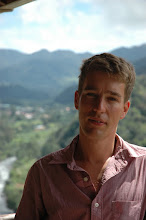Shangri-la
Well, where to begin? Tibet has well and truly banished all memories of China and given us the lift we needed. It is the most remarkable and fascinating country I've ever visited and Lhasa the most mesmorising city. That is not to hide from the problems the country faces in terms of threats to its self-identity and culture, not least with the opening of a railway to Lhasa in the next couple of years (an astonishing engineering achievement that it is). Already Tibetans are outnumbered by Chinese in Lhasa, yet somehow the Tibetan feel of the place seems not to have been diminished, at least not in the old city, which is alive with burgundy robed monks, brightly dressed pilgrims ringing prayer bells, and the piney smell of incense. This is an intensely religious country and Buddhism provides the focus for nearly all facets of Tibetan life.
The great sites of Lhasa which are being brought back to life after much destruction during the Cultural Revolution are all religious in some way or another. Only the Potala Palace, which was the residence and seat of government of the Dalai Lamas, left me a little cold, feeling like a museum rather than a living place. By contrast, the three great monasteries which ring the city are very much alive, and the opportunity to wander at will and observe the monks in debate, in prayer and in relaxed mood has been a rare privilege. These places are like self-contained villages perched in spectacular settings; in the case of Ganden Monastery atop a mountain 1000m above the river valley that flows into Lhasa. Nonethesless, my favourite site has been the Jokang Temple in the heart of old Lhasa. This is the spiritual heart of Tibetan Buddhism, surrounded by a beautiful 'kora' or processional route called the Barkhor which pilgrims process around always in a clockwise direction. What makes it so special is that it's thonging with people from all walks of life, not simply the monks. It's a heaving crush of pilgrims in the dingy interior of Temple itself, a place in which the atmosphere hangs heavy with the smell of incense and the yak fat used for burning candles. Images of the Buddha in various incarnations abound within, and outside the Temple (though within the complex), a second kora route is entirely lined with prayer wheels which pilgrims spin with their hands as they walk past. Goodness knows how many rolls of film I got through there.
However, perhaps even more than the great architectural treasures of Tibet, it is the people themselves who provide the focus of our fascination. All of us on the trip have been madly snapping photographs of the people, who to a considerable extent continue to wear brightly embroidered traditional clothing, sport exotic headwear and jewellery, and who so often have the most appealing faces, frequently creased and lined from hard lives lived under an intense Himalayan sunlight. En route to Lhasa we stumbled by chance on a rural horse racing contest and were able to wander at will attempting to communicate with the local families as the only non-Tibetans present. Another amazing experience.
Where we have experienced some difficulties has been with altitude sickness. The three day journey from Golmud takes you over a series of passes between 4800 and 5100m (higher than Mont Blanc), and never drops below 4000m until you are literally about to arrive in Lhasa. Camping at such altitudes we all felt the effects of headaches, breathlessness at night, and in some cases nausea too.
For much of the way the landscape of the Tibetan Plateau is absolutely desolate. I've never seen a place where the absence of life is more apparent. Settlements are few and far between and the main sign of life is the occasional circling vulture, and the ever present sight of the new railway line. Even the hills seem low, so that apart from the altitude sickness symptoms it often doesn't feel that you are especially high. And then you cross the final 5100m pass half a day from Lhasa and everything changes. The mountains are suddenly soaring and snow-capped, the valleys are green and cultivated with barley crops, mud and stone built villages with flat-roofed houses dot the landscape, and herds of shaggy haired yaks are everywhere to be seen. It makes for a breathtaking scene, and those in the know tell us that things are only going to get more beautiful as we head out of Lhasa on the Friendship Highway towards Nepal.
...And I haven't even mentioned the cricket yet! It was another nail-biter for the English passengers, this time in Lhasa desperately checking our mobiles for text messages. At least we had a decent signal. Graeme, Andy and I are now so frustrated at missing the action that we're researching accommodation in Kathmandu with access to satellite television so we can finally get to see some of the Fourth Test. Surely the Nepalese are cricket lovers!


0 Comments:
Post a Comment
Subscribe to Post Comments [Atom]
<< Home